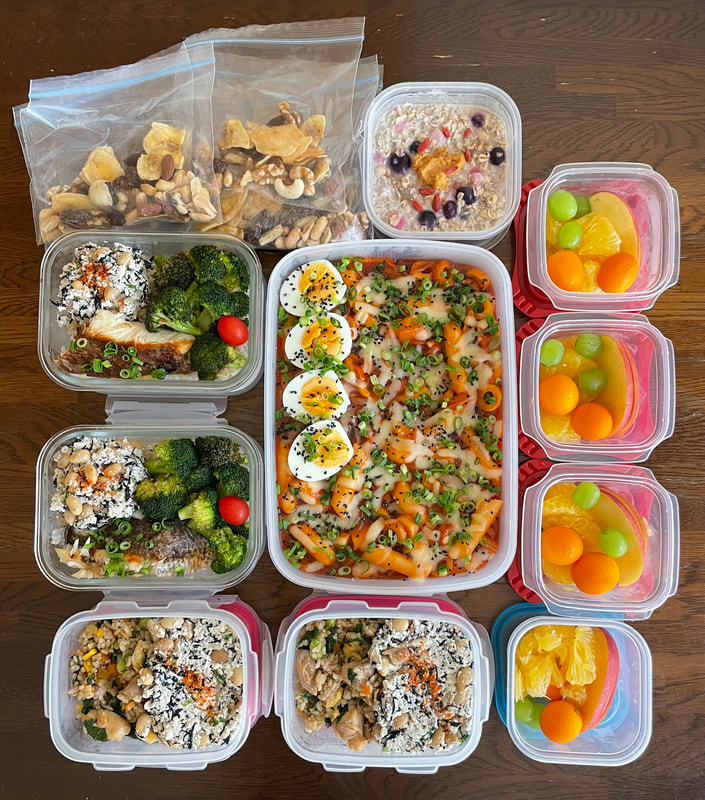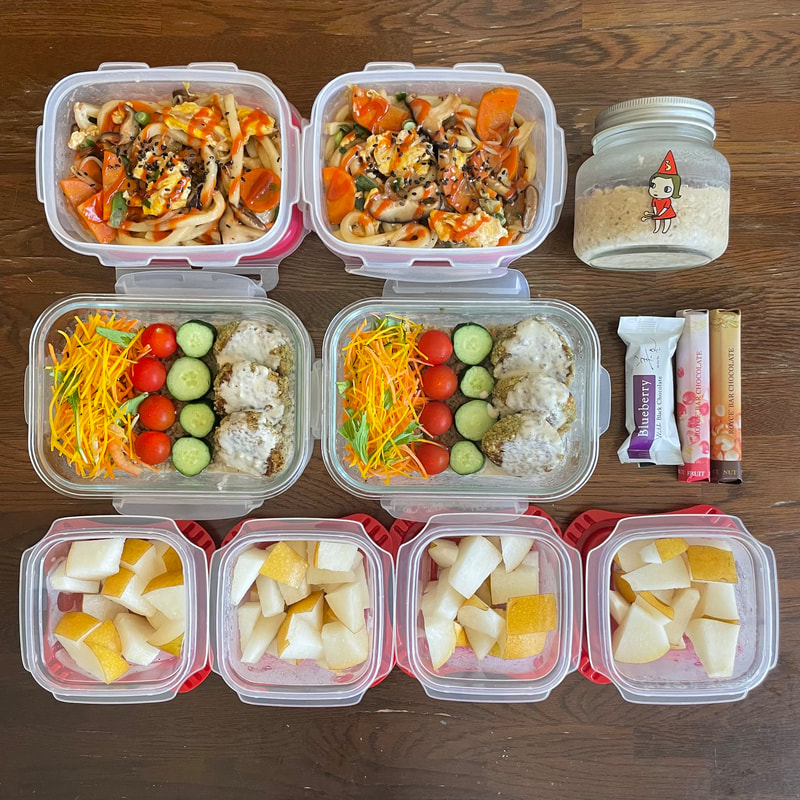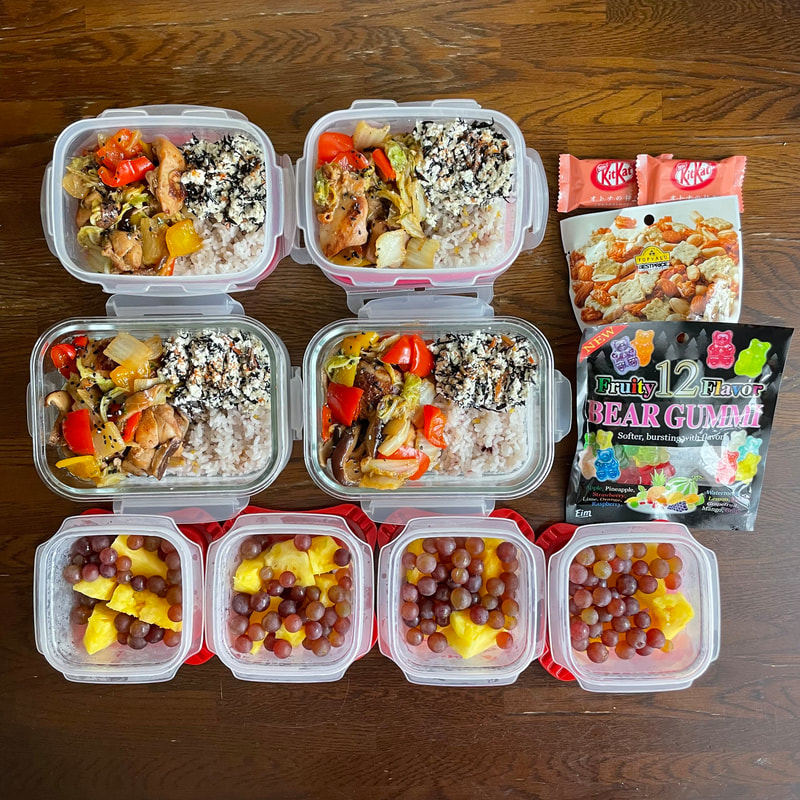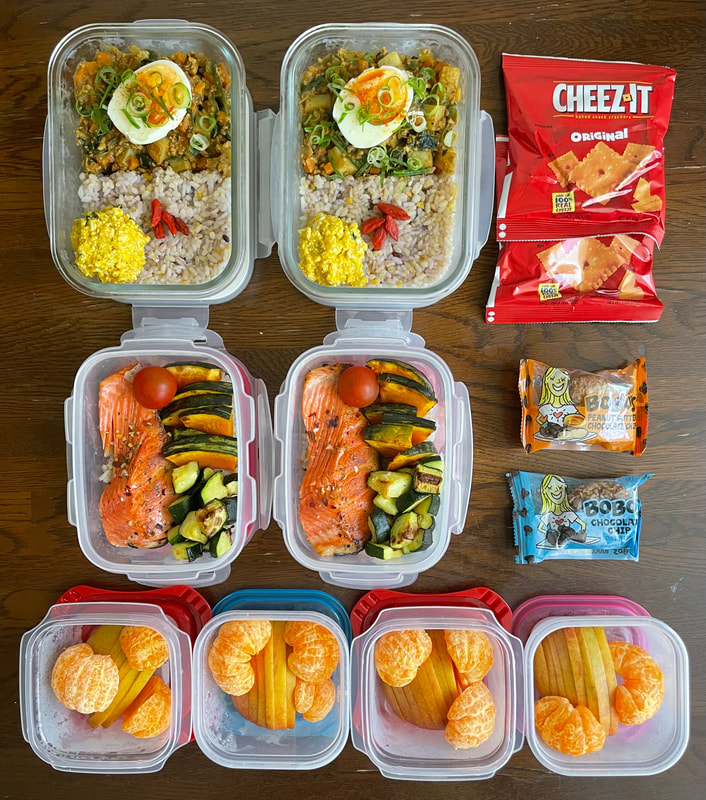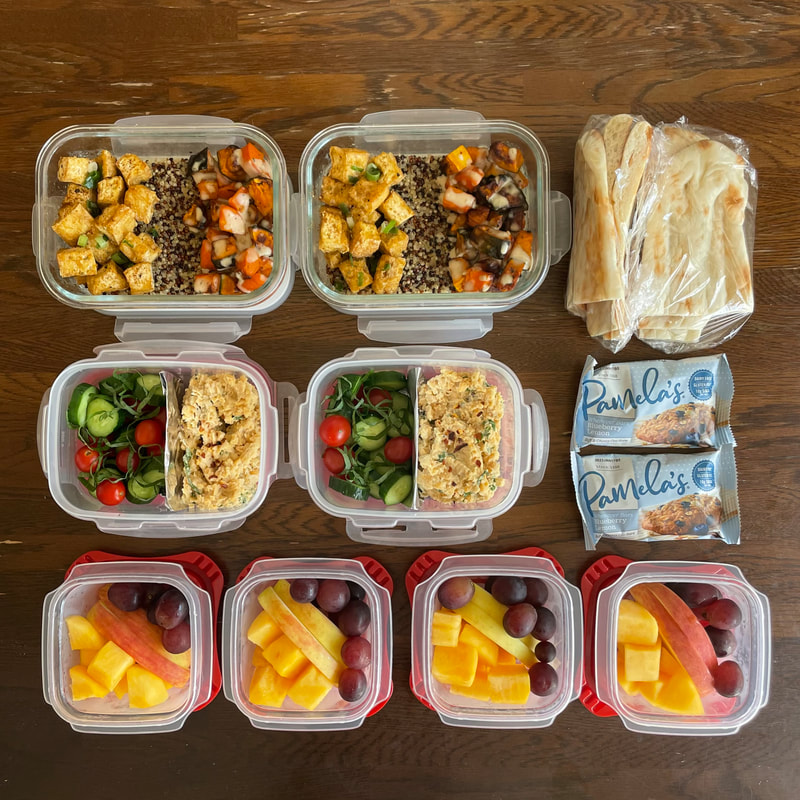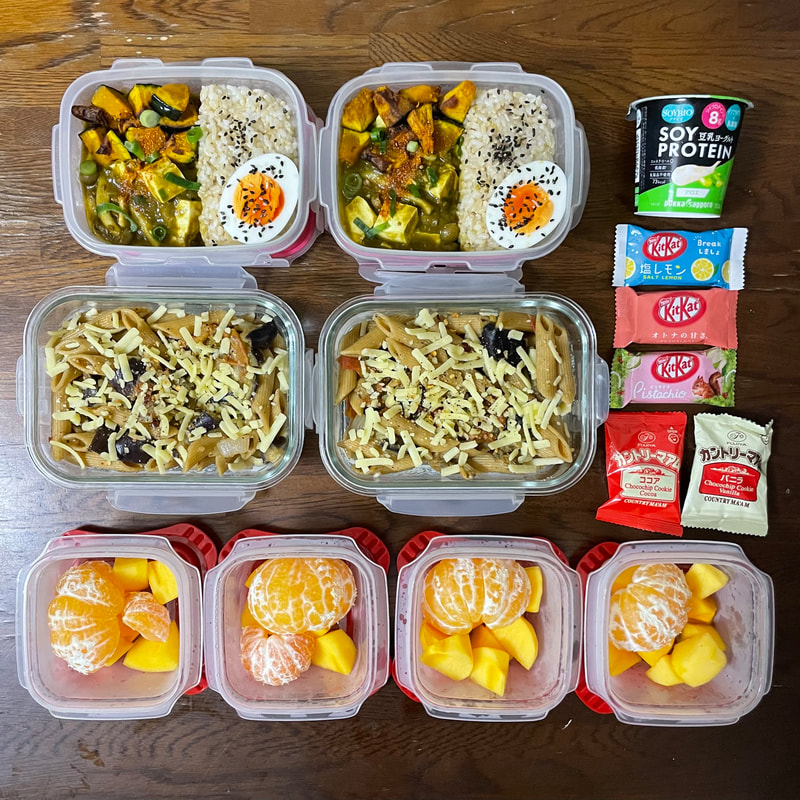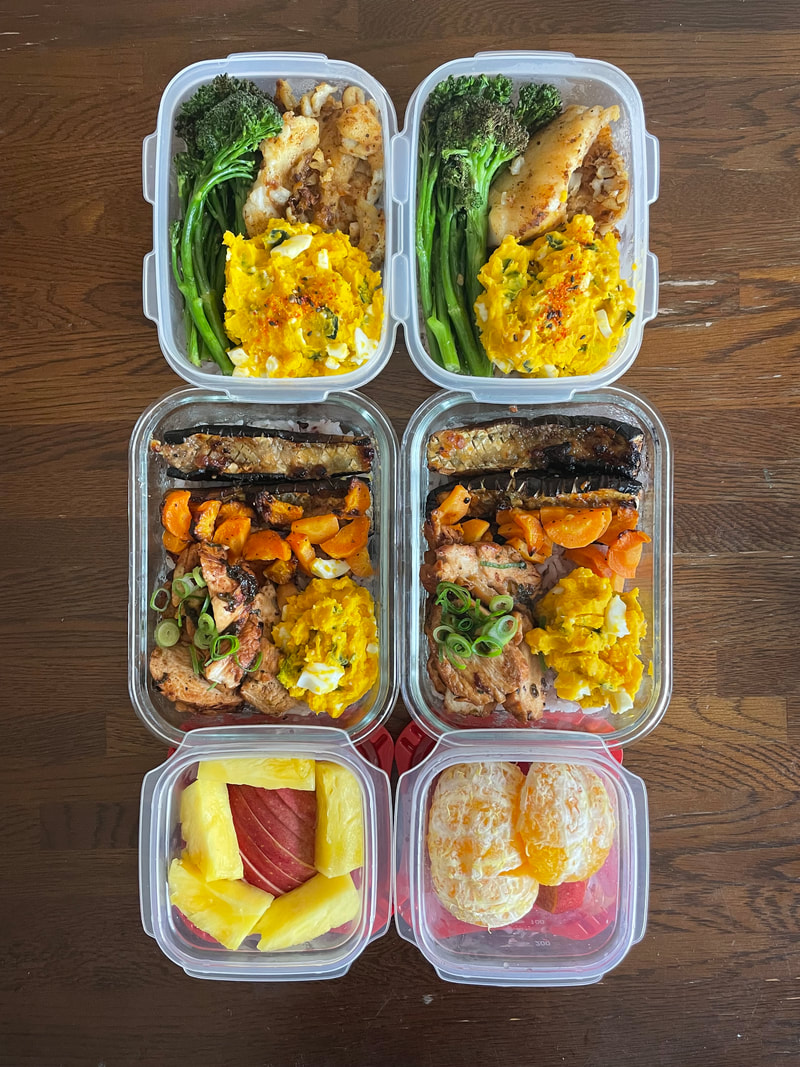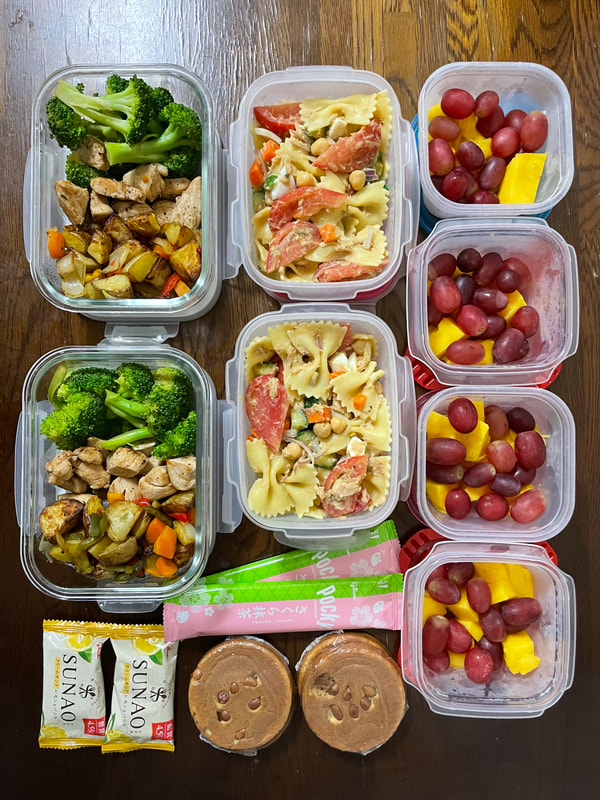|
Once a week, in the name of meal prep, I fill almost every container I own with brightly-colored, neatly-arranged, ready-to-go foods. I do this primarily for healthy, productive reasons: to nourish my body, to make efficient use of my time, to keep my spending in check. I do this secondarily so I can post a pretty flat lay on Twitter and impress three to four strangers. Meal prep, in its broadest definition, is any active planning and preparation of food to eat in the future. This can be chopping fruits and vegetables ahead of time, cooking a massive quantity of food to freeze for later consumption, or making whole meals ahead of schedule. In this blog, I focus on the particular style of meal prep that I practice: preparing several individually-portioned meals in advance. Among first-time meal preppers, the biggest mistake in approach is misunderstanding what meal prep entails. Learning how to meal prep is not simply learning how to make one week’s worth of food in a single go. It’s learning how to make one week’s worth of food in a single go every single week, in perpetuity, and actually eating it. This is a very different challenge. Ultimately, meal prep is an exercise in forecasting. What will you, four days from now, desire to eat? What will you -- given the constraints of time, the temptations of the modern world, and the unforeseeable circumstances of life -- realistically prepare and consume? As expected, meal prep will give you essential kitchen skills and easy access to high-vibrational domestic bliss. Both are a pleasure to possess. But more valuably, it will teach you how to apply self-knowledge to follow through on your decisions. If you give a man a fish, he will eat for a day. If you teach a man to fish, he will eat for life. If you give someone a one-week meal prep plan, they will eat well for a week. If you teach someone how to meal prep, they will eat well for life. As such, this blog post is not a step-by-step guide on how to make a specific menu of meals. If you want that, I can make you a custom plan, complete with a store-specific grocery shopping list, for a very reasonable price. But that would be selling you a product, and I want you to learn a skill. This blog post is a series of helpful framings and advice to help you tackle meal prep in a wise, minimally onerous way. Section 1 presents the three dimensions of “good” meal prep -- healthy, yummy, varied -- and includes exercises to help you achieve all three. Section 2 provides handy tips to apply at different stages of the meal prep process, all the way from planning to plating. Rather than repeating common-sense advice, I tried to include original information and insights wherever possible. Section 3 acknowledges that meal prep can be hard, offers strategies to make it easier, and concludes with tough love about how you should do it anyway. Section 4 is a breakdown of my meal prep routine, complete with my actual thought process, to give you a more concrete idea of what meal prep looks like. Section 5 answers questions I didn’t address in the main text. Section 6 provides some reasons why one might want to meal prep, as well as details my own motivations. Overall, the blog aims to lessen the struggles associated with meal prep and to guide you towards a stress-free, individually-tailored, and maximally beneficial meal prep practice. Before we begin, take a second to remember that you have spent a lifetime living and eating. You know what your life is like. You know what you like to eat. You know what you don’t like to eat. You know yourself. All of these qualities make you exceptionally capable of meal prepping, and meal prepping well. SECTION 1: WHAT IS GOOD MEAL PREP? To make good meals, you first have to know what good meals are. I present a rudimentary model of what makes meal prep good. This refers strictly to the food itself, not the process of making it. We’ll get to that later! The three dimensions of good meal prep are as follows:
Depending on the person and their goals, each of these will be weighted to different degrees. The following three subsections provide guidance on how to accomplish each dimension, invitations for you to apply the concept, and a consideration of what meal prep might look like for someone who doesn’t prioritize that criterion. By the end, I hope you’ll have a good idea of what you, specifically, want out of your meal prep. 1A - UNDERSTANDING THE BUILDING BLOCKS OF A MEAL Remember the food pyramid in your elementary school cafeteria? When you make a balanced meal, you’re trying to include as many of those food groups as possible, particularly fruits and vegetables. In my non-scientific, unregistered dietician opinion, a complete meal includes a:
I strive to include all four in my meal preps, which leads to most of my lunches looking like this: a main dish comprised of a carbohydrate base, a protein, vegetables, plus a side of fruit. (The secret, optional fifth category is a little treat.) When starting out, I think that trying to make meals that include all four categories provides helpful direction. Rather than trying to pick from unending possibilities, you’re just trying to identify four things that kind of work together. Let’s try it! Carb? Potato. Protein? Chicken. Vegetable? Green beans. Fruit? Grapes. After scanning my brain for ways to prepare each ingredient, I’m thinking mashed potatoes, grilled chicken, and roasted green beans with a side of grapes. That sounds Thanksgiving-y, so maybe turning the green beans into a green bean casserole or making gravy would tie everything together. Perhaps an autumnal fruit, such as pears or persimmon would provide a more cohesive, seasonal dining experience. There you go! That is how I go from filling in the categories, to making adjustments to suit my preferences, to having a complete meal idea. Some people have extremely specific nutrition plans and track macros, micros, protein intake, etc. But for most of us with “health” as a general, nebulous goal, I think hitting on these four groups does the trick. Invitations:
It’s worth noting that meal prep doesn’t necessarily need to be healthy. One of my previous roommates used to save McDonald’s coupons until he had enough to purchase several discounted hamburgers at once, which he then stored in our shared refrigerator and ate over the course of a week. Once, I meal prepped Annie’s white cheddar mac and cheese. These were both valid forms of meal prep. 1B - MAKE FOOD THAT YOU LIKE EATING Because meal prep is often associated with various nutrition-minded types (gym bros, health-conscious moms, office workers who have managed to optimize every aspect of life), I think that the “yummy” dimension of meal prep is often overlooked by first-timers. If you don’t already eat grilled chicken, steamed broccoli, and rice regularly, what makes you think that you’d like to eat it every single day for five days straight? Avoid making the mistake of meal prepping what is popular. Meal prep what you actually want to eat. So what do you like to eat? The question is deceptively simple. Meal prep differs from regular eating in the sense that you’ll be having the same thing multiple times, sometimes a few days old. Because of that, you want to choose dishes that you’ll consistently look forward to eating, likely drawing upon familiar flavors and cuisines. Remember that if you’re so-so about a dish on day one, you’ll hate it by day three. Invitations:
For people who don’t prioritize yumminess, meal prep might simply be a way to support the goal of getting absolutely jacked or keeping the body functioning until we invent meal-replacement pills. Maybe you are sick of Soylent and Huel and want to chew real food? If you just need to feed yourself and don’t necessarily care about whether or not it’s tasty, high-nutrient and time-tested preps such as the chicken-broc-rice combo mentioned earlier are splendid options. However, if you eat for pleasure, putting effort into the yummy dimension will make meal prepping more sustainable in the long run. 1C - MEAL PREP PHENOTYPES: TETRIS MEALS V. SLOP MEALS For many people, meal prep is unappealing because it requires eating the same thing multiple times in the same week. Unfortunately, short of cooking a different meal for each day of the week, meal prep does necessitate some repetition. Luckily, not all is lost. Here is a typology that’s helped me find the balance between efficiency and variety in my meal prep. This will be controversial, but I believe we can sort most, if not all, meal preps into two very broad categories: tetris meals and slop meals. Tetris meals are what is commonly pictured as meal prep. Generally, each component is prepared separately and assembled into one container, sometimes with dividers between each ingredient. A recent tetris meal I made was cous cous, salmon, stir-fried vegetables, and pasta salad. In everyday life, some examples of tetris meals are the barbecue cookout plate, Lunchables, Hawaiian plate lunch, and Japanese bento. I also think that sandwiches and wraps, while not visually tetris-y, would fall into this category by virtue of being constructed from several distinct elements. Slop meals contain three to four of the food categories in one big, semi-homogeneous mixture. Perhaps a less disgusting term for this type of cooking is “one-pot meal”. This includes soups, stews, stir-fries, casseroles, pasta, risotto, fried rice. I present this dichotomy to offer the following advice: If you desire variety, make tetris meals. Tetris meals are comprised of the four categories we discussed in the “healthy” section. As a result, you can mix and match different ingredients, as well as prepare them in different ways to keep things interesting. For example, let’s say you buy a pack of chicken. There are many ways to prepare it. You can shred it and toss it in barbecue sauce, or season it with lemon pepper, or coat it in a soy-ginger sauce. Wow, all very different! How flexible! Now you have three different types of chicken, but you only cooked it once. The downside to tetris meals is that, generally, they will take more time to prepare as you are preparing each component separately, and possibly in several different styles. If saving time is more important than variety, make slop meals. Slop meals are great because everything gets chucked into one cooking vessel, which means less time and fewer dishes. The downside is that you can’t really spruce up a slop meal once it’s made. For example, it is hard to transform lasagna into anything other than lasagna. If you do end up getting sick of a slop meal, remember that you can always freeze leftovers to eat at another time. If you want a little bit of both, make one tetris meal and one slop meal each week. Time allowing, this is what I do! I find that this provides enough variation for me, especially if one dish is Asian-inspired and one is Western. Sometimes I eat my meals in alternating order and sometimes I save my favorite for the end of the week to practice delayed gratification. You’ll find a pattern that works for you. Additionally, having a different treat each day can make your mealtime feel novel, even if the main dish is the same. When I was in the States, I’d buy Pepperidge Farm variety packs and eat a few different cookies each day. In Japan, I often pack specialty kit-kats or regional snacks to look forward to. Invitations:
As a lingering side effect of being raised in the Catholic church, I believe that being able to deny oneself pleasure is an admirable trait. As such, I can force myself to eat the same thing five days in a row by telling myself it’s good for my character. If you have a similar affinity for self-inflicted tests of willpower (or if variety simply doesn’t matter much to you), then you can just make a massive portion of a single dish and eat it a million times. Yipee! SECTION 2: MAKING MEAL PREP WORK FOR YOU At present, my entire attitude towards life can be summarized as “minimize suffering, maximize pleasure.” The following five subsections provide meal prep advice designed to do those two things. 2A - WHERE TO FIND IDEAS Meal prep is just as much planning as it is doing, so knowing where to find inspiration is a major time saver. I’ll start with the most straightforward places to look, recipe websites:
Now, some more creative methods:
Last, my ultimate hack:
2B - KEEP IT STUPID SIMPLE From the outside, it may seem like meal preppers are cooking every single thing from scratch. Some people probably really are. Not me though. I am reheating frozen vegetables, buying pre-packaged sides, and taking shortcuts wherever I can. This is allowed! Your food doesn’t need to be impressive. Your food doesn’t even have to be healthy, yummy, or varied, if none of those matter to you. The core purpose of meal prep isn’t to show off your culinary chops. The core purpose is to feed yourself. Feel free to do whatever you need to in order to make that happen. Use the microwave! Use frozen food! Use packaged foods! Use pre-made sauce bases! Use pre-cut produce! I grant you permission. 2C - GROCERY SHOPPING 101 Make a list! Do not go into the store unprepared. Speaking from experience, you will amass a disjointed collection of non-cohesive ingredients, resulting in lunches comprised of several insubstantial snack foods. Some people find it useful to split their grocery shopping list into two categories: a “master list” of essentials, and “everything else” needed to make that week’s meals. The master list contains things that you like to always have on hand such as rice, pasta, eggs, bananas, etc. Before you leave for the store, you can cross-check your master list against the contents of your fridge and cabinets and make a note of what you need to replenish. “Everything else” includes, well, everything else -- everything you need to cook complete meals. For me, this is usually fresh produce and proteins. I’ll go over my weekly grocery shopping routine in more depth in Section 4! My less obvious grocery shopping advice is to buy the exciting upgrade. The difference between a regular version of a product and a cool, artisanal version is usually less than $10. In my opinion, this is nearly always worth it. I will give you an example. In the States, because I am a 20-something liberal woman, I buy the majority of my groceries at Trader Joe’s. (It is actually politically traitorous for me to shop anywhere else.) There, a pack of plain tofu costs $1.99, but they also sell delicious baked sriracha tofu -- extra-firm, well-seasoned, already pressed -- for $3.99. I could just make my own baked sriracha tofu, but I detest waiting for tofu to drain. In this situation, even though the baked tofu is double the price, it’s preferable to buy it because it saves me the pain of an unpleasant cooking experience -- and affords me the pleasure of feeling bougie. I think this advice to “buy the exciting upgrade” extends well to any basic ingredient, such as a fancy heirloom tomato over the standard Roma, or kimchi fried rice over plain rice. Pay a little extra for the fun thing, especially if it’s the difference between you looking forward to and dreading your meal. Remember, if you decide you’re not feeling the meal prep and opt to eat out instead even once, that translates into something like $10-25 of unaccounted spending. Splurge at the store, not at a restaurant. 2D - LEAVE ROOM FOR LIFE None of us can predict future events, but we can take some pretty good guesses at what might come up in a typical week. You might have noticed that I only prep four lunches a week despite having a five-day workweek. That is me leaving room for life. I keep that sneaky fifth slot open for the unknowns, whether that’s a spur-of-the-moment lunch invite, a sudden craving for a meal out, or dinner leftovers that need to be finished off. If you need to be strict on yourself for budget or health reasons, commit to eating a certain number of homemade meals each week. For all the other times, follow your whims completely guilt-free. Meal prep shouldn’t cut into your ability to be spontaneous. Make it fit your life, not the other way around. 2E - PRACTICAL AESTHETICS Meal prep absolutely does not need to be visually appealing, but I think it’s best when it is. The easiest way to make your food look good (and keep it looking good) is to put it in a high-quality, air-tight container. If you’re committed to becoming a meal prepper, nice containers are the first thing you should invest in. Not only do they set the tone for your eating experience, but they also keep your food fresh. Do a quick Google search and find some options that work for you. You might want to consider price, material (glass, plastic, metal, bamboo), configuration (one section, two sections, three or more sections), and any special characteristics (microwavable, freezable, leak-proof, whether or not it has a cute picture of Miffy on it, etc.). You’re going to need to put the food in something, so why not put it in something that is pleasant to look at and eat out of? The other, slightly harder way to make your food look good is to arrange it tastefully. On one hand, this is a gratuitous extra step. On the other, it’s very practical. We eat with our eyes as well as our mouths. For me, it is always worth spending a little extra time making sure the food looks appetizing. One tip to aid in your plating -- garnishes go a long way. A little sprinkle of chopped parsley, green onion, red chili flakes, or black sesame can add that little extra something that ties everything together. SECTION 3: HOW TO MEAL PREP EVEN THOUGH IT’S HARD As Timothée Chalamet has pointed out, “Societal collapse is in the air.” I agree, and it sucks. Unfortunately, the collapse of society does not exempt us from needing to eat. Here, I address two things that make meal prep hard -- being sad and being broke -- and try my best to find ways to accommodate both. Then, I get mean and deliver harsh advice. Enjoy! 3A - DEPRESSION-PROOF YOUR MEAL PREP ROUTINE On occasion, you will find yourself in the trenches, completely devoid of the energy and self-love that meal prep requires. That’s okay. We are not looking for perfection. But we are looking to make meal prep as frictionless as possible so that it’s surmountable even during bad weeks -- so that we get as close as we can to our ideal results as often as we can. Here are some ideas for low-prep, low-effort foods within each of the four categories:
A cohesive meal using the ingredients above could be: cajun-flavored rice made from a package, chicken sausage, and a side of frozen peppers. Plus fruit! Or: lentils, rotisserie chicken, and fresh tomato and cucumber with your favorite dressing to top. One more: mini sandwiches made from Hawaiian rolls, vegan patties, and pre-washed salad mix. Add a spread for pizzazz and have some berries. Additionally, within the “slop meal” category, I think any reheat-and-eat meal zhuzhed up with produce is a decent option. For example, buy frozen fettuccine chicken alfredo, then stir in some frozen broccoli as you warm it on the stovetop. Or just microwave the whole thing. Then eat some pre-cut apple slices. That’s all four categories! Huzzah! Meal prep, like all life maintenance, is ironically the least helpful when you’re doing well. When you’re feeling good, waking up a bit earlier to make lunch or stopping by the store after a long day of work is manageable. But when you’re down, it’s easy to skip meals or eat junk food that makes you feel worse. This means that it’s even more important to make an effort to meal prep when you’re stressed, sad, or otherwise not at your best. Very unfair, I know. My hope is that the examples above illustrate that meal prep can be relatively easy, or at least easy enough to tackle even during hard times. 3B - RECESSION-PROOF YOUR MEAL PREP ROUTINE Groceries are expensive. Eating out is even more expensive. Accordingly, meal prep will almost always be cheaper than not meal prepping. Nonetheless, cheaper doesn’t necessarily mean cheap, so here are some ways to grocery shop on a budget:
3C - CONSTRAINTS VS. EXCUSES I will now shed my amiable, compassionate personality to reveal a hardened, no-nonsense, 100-emoji-using, entrepreneur-hustler mentality. Meal prep, like all things, takes time and energy. Accordingly, the two most common objections, even among those who genuinely want to incorporate it into their lives, are:
I concede that we are constrained by limited amounts of time and energy. But we are also in complete control of how we spend both. Instead of saying “I don’t have enough time or energy”, I request that you try saying “I am not willing to spend my time and energy on that.” The former is a non-starter. It is disenfranchising, it robs you of a solution. You cannot bargain your way into more time or endless energy, this is a fact. The latter makes room for your free will. It affirms that you can do something different, if you’d like. It demonstrates self-knowledge and personal autonomy. It establishes that you are the curator of the contents of your life, should you choose to assume responsibility for that role. For some people, it legitimately doesn’t make sense to meal prep. That’s valid. I won’t claim that meal prep is a good fit for everyone. But if you believe that meal prep would be advantageous for you, then “I don’t have enough time or energy” is not the full truth and thus, not an empathy-inducing excuse. At this point, you have probably realized that I am not talking exclusively about meal prep. For anything that you’d like to do, remember that you are utterly empowered to spend your time and energy pursuing it. Acknowledge that you have choices. Experiment with how accountability feels. Make peace with your freedom, relish it, rub it against your cheek. SECTION 4: HOW I MEAL PREP (AN ILLUSTRATIVE EXAMPLE, NOT A PRESCRIPTIVE GUIDE) Time to walk you through my actual meal-prep routine! Like, I’m legitimately planning my meals whilst writing this. Because I’ve been meal prepping in some form or another for almost a decade (and doing it with a great deal of intention for the past couple of years), my process might look a little different than yours. Some parts might seem weirdly intense, others much less involved than expected. As this is an overview and not an instruction manual, there will be gaps in my explanation, though I’m sure you’ll be able to intuit the parts I neglect to include. As a final caveat, like everything in life, meal prep is person-specific and there’s no one right way to do it. This is just what I do! STEP 1 - ONGOING BRAINSTORMING Throughout the week, I use a Google Doc entitled “Meal Prep” to take notes on all my food-related thoughts. I jot down things like the ingredients I’m out of, meal ideas I could conceivably make with pantry staples I already have on hand, and any cravings or delicious-looking things I saw other people eating on my timeline. By Friday evening (the earliest I do my weekly grocery shop), I’ll have the bare bones of a shopping list, one or two meal ideas I could flesh out with fresh produce, and a vague sense of what I might want to eat the following week. Before heading to the shops, I’ll also take a peek inside my fridge and pantry to refresh my memory on what I already have and what I need to use up. Here’s what my actual “Meal Prep” document looks like right now, on Wednesday afternoon: Meal Ideas:
Shopping List:
STEP 2 - CONCRETE PLANNING Okay, now to solidify my game plan. To restate my goals, I need to decide upon two lunch ideas and write the grocery list necessary to make them. It looks like I have one lunch idea locked: seafood tomato pasta. I know I have dry pasta, a jar of tomato sauce, and frozen seafood mix at home. This is a good start, but I’m interested in making a more nutritionally dense meal, so I think about vegetables that I could easily stir into pasta sauce. Bell peppers, onions, eggplant, and spinach all come to mind. Eggplant and onion seem like a good combo, and I already have an onion, so I add eggplant to my shopping list. I’m also aware that it’s impossible to make pasta in any quantity less than “enough to feed an army”, so I make a mental note that I’ll have plenty of leftover pasta for dinner throughout the week. Next, I turn my attention to the other dish for the week. Since the first one is pasta (a slop meal), I’d like the second one to be a tetris meal. Chinese food has been on my mind ever since I had an exquisitely tasty black vinegar-themed Chinese lunch, plus the weather is cooling down, so something saucey paired with rice sounds primo. Thinking about the container of silken tofu that’s been sitting in my fridge for a week, mapo tofu comes to mind. I can keep things easy by getting a pre-made mapo tofu sauce mix. Since I cook pescatarian at home, I’m interested in substituting the meat in mapo tofu for something else. Mushrooms seem like the logical choice; I’ll get shiitake and enoki since they have a slight “meaty” bite. Now, to decide on the vegetable. I’m pretty flexible here, so I’ll write down a bunch and pick up whichever is most affordable and appealing in the moment: green beans, Chinese broccoli, cabbage. If everything is expensive (or I don’t want to chop things), I can always default to frozen broccoli. So, to recap, the meal is rice, mapo tofu with mushrooms, vegetable side. It seems okay, but I’m a little worried about protein because #gains, so I’m thinking that I can throw some frozen edamame into the mapo tofu and top each meal with half of a boiled egg to add volume. I’ll cook a big pot of rice so that I can use the leftover rice for dinners throughout the week. I don’t prep my dinners exhaustively, but it’s nice to have parts of them on hand. And with that, both my lunch ideas are set! Now, it’s time for the fun parts. I always make fruit sides, so I add a note to buy fruits. It’s persimmon season, so I’m looking forward to grabbing those. I also like having sliced cucumber in my fridge for when I want to chew on something, but I’m not necessarily hungry. Next, snacks! I have a small mass of chocolates and granola bars at home, so I feel pretty set here. If something jumps out at me while I’m perusing the store, I’ll let myself buy it. Last week, I got a sesame ball, honey butter roll, and earl grey ice cream. Now that it’s autumn, I’m expecting there to be some seasonal treats like kabocha bread or chestnut cakes. If you’re a fellow bev appreciator, getting snazzy drinks (kombucha, matcha lattes, bubbly water, etc.) is also a nice way to spice up a lunch. I’ll let the store speak to me. I usually skip breakfast, but I like eating breakfast food for dessert or dinner, so yogurt is one of my “master list” staples. I add it to my shopping list. I also need soy milk, so I add that as well. Last, I consider what might make my meals more fun to eat. For the pasta, it’d be nice if I had some cheese to melt on top. It’s been a couple of months since I last bought cheese, so this would be a nice, but reasonable splurge for the week. I’ve also been craving cheese naan and can use it for that! Cheese naan could also be a good foundation for a dinner. I add mozzarella cheese to my list. At this point, I like to do a sanity check. Can I realistically prepare what I have planned with the amount of time I have? This weekend, I’m hiking all day Saturday and going on a cruise on Sunday. I decide to grocery shop on Friday night so I have everything I need to hunker down and cook as soon as I get home on Sunday evening. The pasta should take no time at all - I just need to throw everything together and stir. Tofu should also be chill since I’m using a pre-made sauce. Okay, yahoo! I’m feeling pretty good about my plan! STEP 3 - GROCERY SHOPPING It is now Friday. My updated meal prep list looks like this: Meal Ideas:
Grocery Shop:
I arrange my shopping list to match the order that I encounter products in the store. This helps me avoid running around and doubling back more than necessary. Snacks get listed last for two reasons: one, so that I can take my time doing a leisurely peruse at the end of my trip and two, so that I don’t blow my budget on treats before picking up the essentials. Here’s how my shopping went. I quickly gathered my fruits (bananas, persimmon, a discounted pear) and eggplant for the pasta. No problems there. When it came to collecting ingredients for the mapo tofu, I encountered a bit of trouble. After already picking up the mushrooms and a cabbage mix, I realized that mapo tofu sauce base is not meat-free. After a little bit of fretting, I accepted that I had to pivot. I spotted these enticingly packaged plant-based keema curries with soy protein, so I grabbed two of those instead. Were they overpriced? Yes. Does seeing intentionally vegan food in Japan excite me? Yes. Hence, I made the purchase. I figured I could toss the tofu in there with some mushrooms for a similar, hearty, Asian-flavored meal. I put back my enoki mushrooms and grabbed shimeji instead (they were out of shiitake) and swapped out the cabbage for kabocha as the vegetable side. (I know pumpkin is technically a fruit. Don’t come for me). I ended up with the ingredients for a radically different meal than what I intended but still made up of the same core components: a sauce base, mushrooms, and a vegetable. I grabbed my frozen broccoli, naan, a big tub of yogurt, soy milk, and soy vegan cheese instead of mozzarella. For snacks, I picked up an aloe-flavored single-serve soy yogurt (on sale!) and a chocolate protein bar. All set! STEP 4 - COOKING AND ASSEMBLING From start to finish, it takes me about three hours to complete a full prep - that’s four lunches, plus plenty of extras for other meals. I use the time to catch up on my beloved podcasts. My cooking generally follows the pattern below. To elaborate on what each step entails, I listed what I did for this particular week of meal prep.
Hot tip: if you chop things in the order advised, then you can simply rinse your cutting board in between ingredients instead of doing a full wash. As you can see, I don’t use recipes or fancy techniques. I mostly just stir things around! It works great! SECTION 5: AUDIENCE QUESTIONS The content of this blog was determined by questions nice people asked me online. I answered as many as I could in the sections above, but couldn’t find a way to weave in all of them. Here are some of the ones I missed! If you think of any more, feel free to leave them in the comments!
SECTION 6: WHY YOU SHOULD MEAL PREP Throughout this blog, I’ve spent a lot of time talking about the “how” and significantly less time talking about the “why”. That’s because I think the reasons to meal prep are fairly common-sense, kind of like the reasons why you should be nice to people. Because of that, and because I am very sleepy, I prompted an AI to give me the “five main reasons why you should meal prep”:
Wow, technology is sick. I agree with all the points. I’d like to add one more: 6. Meal prepping can lead to positive feedback from people online. Personally, I meal prep because I want to eat healthy, yummy, varied food, and find that it’s the most time and cost-effective way for me to do so. When I think about what I can say that an AI can’t, it’s this. Self-knowledge is extremely sexy. Good follow-through is extremely sexy. Taking care of yourself is extremely sexy. Meal prep is a training ground for all three. Give it a try, and send me pictures of your meal prep when you do. Let’s be extremely sexy together. “I love you. I want us both to eat well.” - Our Beautiful Life When It’s Filled with Shrieks, Christopher Citro
7 Comments
pat <3
10/26/2022 07:15:52 pm
powerful last words!!!
Reply
brit
10/30/2022 03:52:48 am
thank you for reading pat <3
Reply
Ashley
10/27/2022 09:06:49 pm
Oh my god, I am so excited to dig into this!!!! Read the phrase "high-vibrational domestic bliss" I know this is going to be so good
Reply
brit
10/30/2022 03:53:25 am
bahaha, that might be my favorite phrase in the whole piece! hope you get some good tidbits out of the material :)
Reply
mish
11/12/2022 10:12:07 pm
this was such a good read! i've always been fascinated by meal prep, but it is admittedly a bit intimidating...until this came around! i love that meal prepping is kind of like a window to someone's tastes, literally! yummy, informative, and so, so healthy for both your gut and mind--i'll definitely keep this one tabbed for later.
Reply
brit
11/13/2022 04:17:59 pm
hi mish!! yesss, absolutely in agreement with your assessment of meal prep as a "window to someone's tastes" - i think we learn so much about ourselves through food!
Reply
r
1/10/2024 12:38:16 am
(sorry for necro-commenting) Weirdly enough, the thing that puts me off the most is that I just don't enjoy microwaved food a lot. I like meal prep for things I eat cold (couscous/pasta/etc based salad mixes), but microwave heated hot meals kinda put me off.
Reply
Leave a Reply. |
categories |


